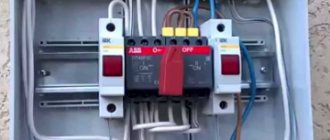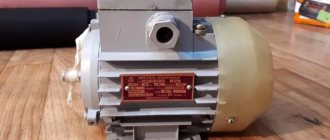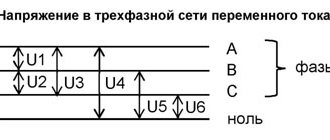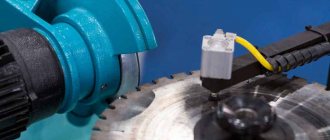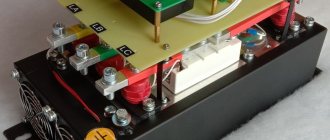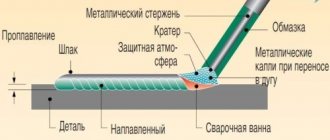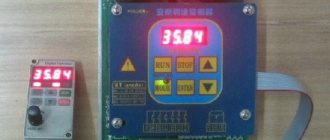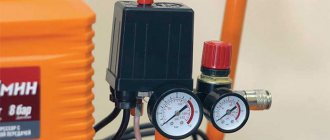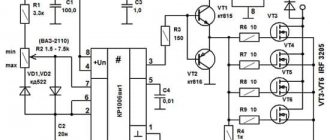Three-phase asynchronous motor: what to pay attention to before connecting it
With a few exceptions, we get the asynchronous machine in an unknown state. Very rarely does it have an inspection certificate and a certified warranty from an electrical laboratory.
Even in this case, I recommend making sure it works personally.
Mechanical condition of the stator and rotor: what can interfere with engine operation
The fixed stator consists of three parts: a middle housing and two side covers, secured with studs. Pay attention to the gap between them and the tightening force with the nuts.
The body must be tightly compressed. A rotor rotates inside it on bearings. Try turning it by hand. Evaluate the force applied: how the bearings work, whether there are any beats.
Without proper experience, minor defects cannot be detected in this way, but a case of severe jamming will immediately appear. Listen to the noises: is there any contact with the stator elements by the rotor when rotating?
After turning the engine to idle and running for a short time, listen again to the sounds of rotating parts.
Ideally, it is better to disassemble the stator, visually assess its condition, wash the dirty rotor bearings and completely replace their lubricant.
Electrical characteristics of stator windings: how to check the assembly circuit
The manufacturer indicates all the main parameters of the electric motor on a special plate attached to the stator housing.
You can trust these factory specifications only if you are sure that after the factory, none of the electricians changed the winding connection diagram or made involuntary mistakes. And I came across such cases.
And the sign itself may become erased or lost over time. Therefore, I propose to understand the technology of rotor spin-up.
To understand the electrical processes occurring inside the motor stator, it is convenient to imagine it in the form of an ordinary toroidal transformer, when three equal windings are symmetrically located on the ring core of the magnetic circuit.
The stator circuit is assembled inside a closed housing, from which only six ends of the windings are removed.
They are marked and connected on a terminal block covered with a lid for assembly according to a star or delta circuit using a standard rearrangement of jumpers.
The right side of the picture shows the assembly of the triangle. I publish the jumper arrangement diagram for the star below.
Electrical methods for checking winding assembly circuits
But not everything is as simple as it might seem at first glance. There are a number of engines that deviate from these rules.
For example, a manufacturer may produce electric motors not for universal use, but for operation in specific conditions with the windings connected in a star configuration.
In this case, he can assemble the three ends of the windings inside the stator housing, and bring out only four wires for connection to the phase and zero potentials.
Installation of these ends is usually performed in the area of the back cover. To switch the windings to a triangle, you will need to open the housing and make additional conclusions.
It's not a difficult job. But it requires careful handling of the varnish coating of the copper wire. When the wire is bent, it may be damaged, which will lead to a breakdown of the insulation and create an interturn short circuit.
After rewiring the circuit, I recommend additionally coating the outer layers of the windings with varnish, and then drying them thoroughly with warm air before final assembly.
What to do if there are no pin markings
On an old asynchronous motor, the wires may be removed from the terminals, and the factory markings may be lost. There were also instances where six ends simply stuck out from the body. They need to be called and labeled.
We carry out the work in two stages:
- We check that the ends belong to the windings.
- We identify and label each pin.
At the first stage, we use a multimeter or tester in ohmmeter mode. We place the first probe randomly on one terminal, and with the second, we look for the one from the five remaining wires where the device will show a shorted circuit. We mark both ends as belonging to the same winding.
We proceed in the same way with the remaining four conclusions. As a result, we get three pairs of wires from each winding.
How to find the end and beginning of a winding: 2 ways
You can search using a voltmeter:
- and batteries;
- or a reduced AC voltage source.
The first method is based on the fact that a current pulse applied to one of the three windings is transformed into the other two.
To do this, connect the negative battery to a randomly selected end of K1, and briefly touch the second terminal with the positive contact. A pulsed inrush current passes through the circuit and induces an EMF in the other two windings.
Using a DC voltmeter, the polarity of the induced voltage in each winding is checked by the deflection of the arrow. The beginning is marked with the terminal that corresponds to the positive potential (the arrow of the device moves to the right when the battery is closed and to the left when the circuit is opened by the battery).
After marking the ends, I recommend checking the correctness of their application by applying a pulse to another winding.
The second method is based on the use of an alternating voltage source of a safe value of 12-36 volts.
The ends of any two windings are connected in parallel and a voltmeter is connected to them. An alternating voltage is applied to the remaining third winding and the reading of the device is looked at.
If the induced EMF corresponds to the applied voltage, then these two windings are connected in the same polarity. Their beginnings and ends are marked equally. If the voltmeter reading is zero, the ends of one of the windings must be unscrewed and the measurement taken again.
Then one of the marked windings, for example No. 3, is connected to the first and a voltmeter is connected to them. The vacated No. 2 is again supplied with alternating voltage. The polarity of the terminals is determined by the magnitude of the EMF on the voltmeter.
After marking is completed, a control measurement is taken to check the work performed.
When there is no step-down transformer or safe power supply at hand, an experienced electrician with the right to independently work under voltage can use an ordinary 60-watt incandescent lamp.
It is used as a voltage divider, connected in series to one winding of the electric motor. 220 volts are supplied to the assembled chain, and the voltage is measured on the other two with a voltmeter.
This kind of testing is dangerous. This should not be done by untrained people: you can easily get an electrical injury.
How to assess the condition of winding insulation
Some bloggers are silent about the need for this check. They believe that they can do without it in most cases.
However, before energizing the engine, I recommend:
- take a megohmmeter with an output voltage of 1000 volts;
- check the insulation between each individual winding and the housing, as well as between all windings;
- if it is higher than 0.5 MΩ, then consider the starter to be in good condition. Otherwise you will have to repair it. Drying with dry and warm air often helps.
Checking the insulation of the electric motor with a megohmmeter must be carried out before connecting it to load. However, it is not able to detect damage to the dielectric layer that causes interturn short circuits in the winding.
When assembling the engine, each stator coil is wound with copper wire of the same length and cross-section. Therefore, they all have exactly the same resistive resistance.
If an interturn short circuit occurs in the winding, then, as a rule, it can be determined by measuring a multimeter in ohmmeter mode. To do this, carefully analyze and compare the active resistance of each chain.
How to check the stator magnetic field at the factory
When voltage is applied to a working electric motor, a rotating magnetic field is created. It is visually assessed using a metal ball that repeats the rotation.
I do not encourage you to repeat such an experience. This example is intended to help you understand that the operation of an asynchronous motor is based on the interaction of the magnetic fields of the stator and rotor.
Only the correct connection of the windings ensures the rotation of the ball or rotor.
Motor power and winding wire diameter
These are two interrelated quantities because the cross-section of the conductor is selected based on its ability to withstand heating from the current flowing through it.
The thicker the wire, the more power can be transmitted through it with acceptable heating.
If there is no plate on the engine, then its power can be judged by two signs:
- The diameter of the winding wire.
- Dimensions of the magnetic core.
After opening the stator cover, analyze them visually.
Checking the insulation resistance of the stator windings
If the engine was stored in an unheated room, it came into contact with moist air and became damp. Its insulation is broken and can create leakage currents. Therefore, its quality must be assessed by electrical measurements.
A tester in ohmmeter mode is not always able to detect such a violation. It will only show an obvious defect: the power of its current source is too low and does not provide an accurate measurement result. To check the condition of the insulation, it is necessary to use a megohmmeter - a special device with a powerful power source that ensures that an increased voltage of 500 or 1000 volts is applied to the measuring circuit.
An assessment of the insulation condition must be carried out before applying operating voltage to the windings. If leakage currents are detected, you can try to dry the engine in a warm, well-ventilated environment. Often this technique allows you to restore the functionality of the electrical circuit assembled inside the stator core.
Connecting a three-phase motor to a single-phase network according to a star circuit
Let me start with a warning: even experienced electricians make mistakes during work, which are called “human factor”. What can we say about home craftsmen...
Therefore, I recommend that voltage be supplied to the assembled circuit only through a separate SF circuit breaker, correctly selected for the load. It will save life and health.
The star connection diagram is shown in the picture.
The ends of the windings are collected at one point by horizontal jumpers inside the terminal box. There are no external wires connected to it.
Phase (via a circuit breaker) and neutral of household wiring are supplied to two different terminals of the beginning of the windings. A parallel chain of two capacitors is connected to the free terminal (H2 in Figure): Cp - working, Sp - starting.
The working capacitor is connected by a second plate rigidly to the phase wire, and the starting capacitor is connected through an additional switch SA.
When starting the electric motor, the rotor must be spun from rest. It overcomes the frictional forces of bearings and environmental resistance. For this period, it is necessary to increase the magnitude of the stator magnetic flux.
This is done by increasing the current through an additional circuit of the starting capacitor. After the rotor reaches operating mode, it must be turned off. Otherwise, the starting current will overheat the motor winding.
It is not always convenient to disable the starting chain with a simple switch. To automate this process, circuits with relays or time-based starters are used.
The start button from Soviet activator-type washing machines is popular among DIYers. It has two built-in contacts, one of which, after switching on, turns off automatically with a delay: what is needed in our case.
If you look closely at the principle of supplying single-phase voltage, you will see that 220 volts are applied to two windings connected in series. Their total electrical resistance adds up, weakening the amount of current flowing.
Connecting a three-phase motor to a single-phase network according to a star circuit is used for low-power devices and is characterized by increased energy losses of up to 50% of a three-phase power system.
Final conclusions
- Existing technical methods make it possible to connect three-phase asynchronous motors to a single-phase 220 volt network. Numerous researchers offer a wide range of experimental schemes for this purpose.
- However, this method does not ensure efficient use of electrical power resources due to large energy losses associated with poor-quality voltage conversion for connection to the stator phases. Therefore, the engine operates with low efficiency and increased costs.
- Long-term operation of machines with such engines is not economically justified.
- The method can only be recommended for connecting non-critical mechanisms for a short period of time.
- In order to effectively use an asynchronous electric motor, it is necessary to use a full three-phase connection or a modern, expensive inverter converter of appropriate power.
- A single-phase electric motor with the same power in a household network is better able to cope with all tasks, and its operation will be cheaper.
Thus, the designs of asynchronous motors, previously widely connected to home wiring, are now not popular, and the method of connecting them is outdated and rarely used.
A variant of such a mechanism is shown in a photograph of an emery board with the protective shield and limit stop removed for clarity. Even with this design, it is difficult to work on it due to power losses.
Practical advice from Alexander Shenrok, presented in his video, clearly complements the material in the article and allows you to better understand this topic. I recommend viewing it, but be critical of measuring the insulation resistance with a tester.
Ask questions in the comments, share the article with friends via social network buttons.
Triangle scheme: advantages and disadvantages
Connecting an electric motor using this method involves using the same external circuit as the star. The phase, zero and midpoint of the lower plates of the capacitors are mounted in series on three jumpers of the terminal box.
By switching the winding terminals in a delta pattern, the applied voltage 220 creates more current in each winding than the star. There are lower energy losses and higher efficiency.
Connecting the motor according to a delta circuit in a single-phase network allows you to usefully use up to 70-80% of the power consumption.
To form a phase-shifting chain, it is necessary to use a smaller capacity of working and starting capacitors.
When you turn on the engine, it may begin to rotate in the wrong direction. We need to reverse it.
To do this, in both circuits (star or triangle) it is enough to swap the wires coming from the network on the terminal block. The current will flow through the winding in the opposite direction. The rotor will change direction of rotation.
Reverse
To change the direction of rotation of the rotor, you need to switch the capacitive circuit to another wire or terminal of the electric motor box. A phase is supplied to one terminal, zero to the other, and the capacitor group is switched on to the third. Now, when the second wire of the capacitor is connected to the phase, the motor rotates in one direction, and when connected to zero, in the other.
This is enough to figure out how to connect a three-phase motor to 220, but if everything worked out and it seems to be working correctly, it turns, does not heat up, does not burn, a simple and in this case optional check will help to finally make sure that the assembled circuit is correct. While working with a constant, identical load, use a current clamp to measure the currents in the phase, neutral and capacitor wires. Ideally, they should be equal to each other; if there are small differences (30 percent), then this is not ideal, but still good.
And the difference in currents is corrected simply - by changing the capacitance of the working capacitor. It is necessary not to make sudden movements and not to burn the winding by installing too large a capacity of the working capacitor.
How to choose capacitors: 3 important criteria
A three-phase motor creates a rotating magnetic field of the stator due to the uniform passage of sinusoidal currents through each winding, spaced apart in space by 120 degrees.
There is no such possibility in a single-phase network. If you connect one voltage to all 3 windings at once, there will be no rotation - the magnetic fields will balance. Therefore, voltage is applied to one part of the circuit as it is, and the current is shifted to the other according to the angle of rotation by capacitors.
The addition of two magnetic fields creates an impulse of moments that spin the rotor.
The performance of the created circuit depends on the characteristics of the capacitors (capacitance value and permissible voltage).
For low-power engines with easy starting at idle, in some cases it is permissible to use only working capacitors. All other engines will require a starting block.
I draw attention to three important parameters:
- capacity;
- permissible operating voltage;
- type of construction.
How to choose capacitors by capacitance and voltage
There are empirical formulas that allow you to perform a simple calculation based on the rated current and voltage.
However, people often get confused about the formulas. Therefore, when checking the calculation, I recommend taking into account that for a power of 1 kilowatt it is necessary to select a capacitance of 70 microfarads for the operating circuit. The dependence is linear. Feel free to use it.
All these methods can and should be trusted, but theoretical calculations must be tested in practice. The specific design of the engine and the loads applied to it always require adjustments.
Capacitors are designed for the maximum current value allowed under the heating conditions of the wire. This consumes a lot of electricity.
If the electric motor overcomes loads of smaller magnitude, then it is advisable to reduce the capacitance of the capacitors. This is done experimentally during setup, measuring and comparing the currents in each phase with an ammeter.
Most often, metal-paper capacitors are used to start an asynchronous electric motor.
They work well but have low ratings. When assembled into a capacitor bank, the result is a rather large design, which is not always convenient even for a stationary machine.
Nowadays the industry produces small-sized electrolytic capacitors adapted for operation with alternating current electric motors.
Their internal structure of insulating materials is adapted to work under different voltages. For a working chain it is at least 450 volts.
For a starting circuit with conditions of short-term switching on under load, it is reduced to 330 due to a decrease in the thickness of the dielectric layer. These capacitors are smaller in size.
This important condition must be well understood and put into practice. Otherwise, 330 volt capacitors will explode during prolonged operation.
Most likely, for a particular engine, you won’t be able to get rid of it with just a capacitor. You will need to assemble the battery using a series and parallel connection of them.
When connected in parallel, the total capacitance is summed, but the voltage does not change.
Connecting capacitors in series reduces the total capacitance and divides the applied voltage between them.
What types of capacitors can be used
The rated voltage of the network is 220 volts - this is the effective value. Its amplitude value is 310 volts. Therefore, the minimum limit for short-term operation at startup is 330 V.
A voltage reserve of up to 450 V for working capacitors takes into account surges and impulses that are created in the network. It cannot be underestimated, and the use of capacities with a large reserve significantly increases the dimensions of the battery, which is irrational.
For a phase-shifting chain, it is permissible to use polar electrolytic capacitors, which are designed to allow current to flow in only one direction. Their connection circuit must contain a current-limiting resistor of several ohms.
Without its use, they quickly fail.
Before installing any capacitor, you should check its actual capacity with a multimeter, and not rely on the factory markings. This is especially true for electrolytes: they often dry out prematurely.
Selecting a starting capacitor for an electric motor
A modern approach to this issue involves the use of special calculators on the Internet that perform quick and accurate calculations.
To carry out the calculation, you should know and enter the following indicators:
- Motor winding connection type: delta or star. The capacitance also depends on the type of connection.
- Engine power is one of the determining factors. This indicator is measured in Watts.
- Mains voltage is taken into account in calculations. As a rule, it can be 220 or 380 Volts.
- Power factor is a constant value that is often 0.9. However, it is possible to change this indicator during calculation.
- The efficiency of the electric motor also affects the calculations performed. This information, as well as others, can be found by studying the information printed by the manufacturer. If it is not there, you should enter the engine model on the Internet to search for information about what the efficiency is. You can also enter an approximate value, which is typical for such models. It is worth remembering that efficiency may vary depending on the condition of the electric motor.
Such information is entered into the appropriate fields and an automatic calculation is carried out. At the same time, we obtain the capacity of the working condensate, and the starting condensate should have an indicator 2.5 times greater.
You can carry out such a calculation yourself.
To do this, you can use the following formulas:
- For the star winding connection type, the capacitance is determined using the following formula: Cр=2800*I/U. In the case of a triangle connection of the windings, the formula Cр=4800*I/U is used. As you can see from the information above, the type of connection is the determining factor.
- The above formulas determine the need to calculate the amount of current that passes through the system. For this, the formula is used: I=P/1.73Uηcosφ. For the calculation you will need engine performance indicators.
- After calculating the current, you can find the capacitance indicator of the working capacitor.
- The starting one, as previously noted, should be 2 or 3 times higher in capacity than the working one.
When choosing, you should also consider the following nuances:
- Operating temperature range.
- Possible deviation from the calculated capacity.
- Insulation resistance.
- Loss tangent.
Usually, the above parameters are not paid much attention. However, they can be taken into account to create an ideal electric motor power system.
Overall dimensions can also be a determining factor. In this case, the following dependence can be distinguished:
- Increasing the capacitance leads to an increase in the diametrical size and outlet distance.
- The most common maximum diameter is 50 millimeters with a capacitance of 400 µF. At the same time, the height is 100 millimeters.
In addition, it is worth considering that on the market you can find models from foreign and domestic manufacturers. As a rule, foreign ones are more expensive, but also more reliable. Russian versions are also often used when creating an electric motor connection network.
Diagram of phase shift of currents with capacitors and a choke: what I didn’t like
This is the third design promised in the title, which I implemented two decades ago, tested it in operation, and then abandoned it. It allows you to use up to 90% of the three-phase motor power, but has disadvantages. More on them later.
I assembled a three-phase voltage converter with a power of 1 kilowatt.
It includes:
- 140 Ohm inductive reactance choke;
- capacitor bank for 80 and 40 microfarads;
- adjustable rheostat 140 Ohm with a power of 1000 watts.
One phase works in the usual way. The second with a capacitor shifts the current forward by 90 degrees along the rotation of the electromagnetic field, and the third with a choke forms its lag by the same angle.
The currents of all three stator phases participate in the creation of a phase-shifting magnetic moment.
The throttle body had to be assembled using a mechanical structure made of wood on springs with a threaded air gap adjustment to adjust its characteristics.
The design of the rheostat is generally “tinny”. Now it can be assembled from powerful resistors purchased in China.
I even thought about using a water rheostat.
But I refused it: the design was too dangerous. I simply wound a thick steel wire around an asbestos pipe for the experiment and laid it on the bricks.
When I started the circular saw engine, it worked normally, withstood the applied loads, and sawed fairly thick blocks normally.
Everything would be fine, but the meter wound up at double the rate: this converter takes on the same power as the engine. The choke and wire heated up quite well.
Due to high power consumption, low safety, complex design, I do not recommend this converter.
Calculation of capacitors
It is clear that you cannot connect the first capacitor you come across to the starting circuit. If the capacity is more than needed, the electric motor will heat up; if it is less, it will not work stably. There are special calculations to find the required values.
Example calculations for a capacitor
I – stator phase current. It is best to measure it with pliers, or, if this is not possible, you can take the values indicated on the nameplate - a tag on the engine frame.
The capacity of the starting capacitor is taken at the rate of 2–3 Operating.
However, all the same, the best option would be to additionally select the required containers experimentally. The table will help with this:
The voltage of the capacitors should be 1.5 times higher than the mains voltage. This is due to the fact that 220V is an effective voltage, but the capacitor will be affected by the full, amplitude voltage. And it is 2 higher than the current one. This is approximately 1.4. A simple mathematical calculation helps you see: 220 * 1.4 = 308 V. Well, if you consider that the outlet rarely has exactly 220, most often the voltage floats in one direction or the other, then you need to take a higher value.
Reconnection from 380 volts to 220
It is very important to understand how a three-phase electric motor is connected to a 220V network. To connect a three-phase motor to 220V, note that it has six terminals, which corresponds to three windings. Using a tester, the wires are pinged to find the coils. We connect their ends in twos - we get a “triangle” connection (and three ends).
To begin with, we connect the two ends of the network wire (220 V) to any two ends of our “triangle”. The remaining end (the remaining pair of twisted coil wires) is connected to the end of the capacitor, and the remaining capacitor wire is also connected to one of the ends of the power wire and coils.
Whether we choose one or the other will depend on which direction the engine starts to rotate. Having completed all the above steps, we start the engine by applying 220 V to it.
The electric motor should work. If this does not happen, or it does not reach the required power, you need to return to the first stage to swap the wires, i.e. reconnect the windings.
If, when turned on, the motor hums but does not spin, you need to additionally install (via a button) a capacitor. At the moment of starting, it will give the engine a push, forcing it to spin.
Video:
Video: How to connect an electric motor from 380 to 220
Calling, i.e. resistance measurement is carried out by a tester. If this is not available, you can use a battery and a regular flashlight lamp: the identified wires are connected to the circuit in series with the lamp. If the ends of one winding are found, the lamp lights up.
It is much more difficult to determine the beginning and ends of the windings. You can't do without a voltmeter with an arrow.
You will need to connect a battery to the winding, and a voltmeter to the other.
By breaking the contact of the wire with the battery, observe whether the arrow deviates and in which direction. The same actions are carried out with the remaining windings, changing the polarity if necessary. Make sure that the arrow deviates in the same direction as during the first measurement.
